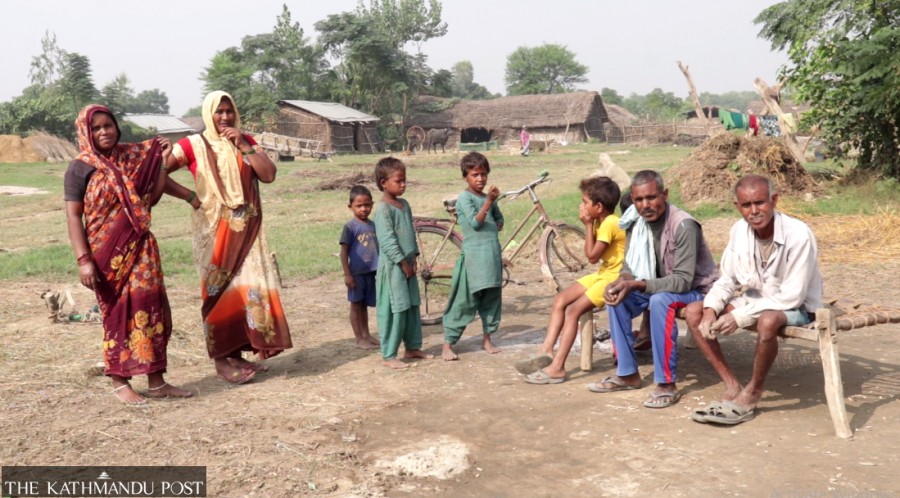
On October 7, Anita Kewat saw no escape and climbed onto the roof of her hut clutching her infant daughter. The floodwaters from the Rapti river had started entering her village Chaupheri in Duduwa Rural Municipality-2. The water was already waist-high and would soon sweep away her hut.
“Soon after, the water reached the roof. I jumped into the water and swam to my neighbour’s roof with my daughter in tow. The next four days were miserable for us. We stayed put on our neighbour’s roof, hungry and scared,” said Kewat. “I saw my whole settlement getting swallowed that night.”
The floodwaters from the river had completely submerged Chaupheri and its neighbouring villages in October. The villagers spent a week trying to find safe spaces, says Kewat. “Our houses were submerged in water. We had lost our livestock and every single grain in the house.”
According to Nakke Chai, a local of Ramnagar, another village affected by the October floods, all the villagers climbed onto trees, roofs, or other high places in order to save their lives. “There was no food or clean drinking water for a week. It’s a wonder we all survived,” said Chai.
According to the municipal office, around 500 households in the settlements of Chaupheri and Ramnagar, in ward 2 of Duduwa Rural Municipality were affected by the October floods.
These two villages have been facing inundation and floods every year during the monsoon season for more than two decades now. “We have been living with the same problems since 1998-99. Inundation affects every aspect of our lives—from losing fertile fields to our livestock,” said Chai.
The two villages suffer power cuts and a shortage of drinking water every monsoon. But even during the dry season, they don’t live comfortably, say locals. “Our children remain out of school as there is none nearby and we succumb to minor ailments and injuries without access to a hospital,” said Chai.
“In the last 25 years, Chaupheri and Ramnagar have been inundated more than 55 times. Several people have also lost their loved ones,” said Aagyaram Godiya, a 55-year-old man from Ramnagar. “In the monsoon of 2014, I saved myself by climbing a tree. I stayed on that tree—hungry—for three days. But it wasn’t easy even after the water drained out because all our winter harvest was washed away.”
Residents say the local authorities are aware of the difficulties faced by the two villages but they are yet to extend help.
Sundarlal Loniya of Ramnagar says flooding is becoming worse every year with erratic monsoon. “Earlier we tackled flooding only during the monsoon season but in the last few years, even pre- and post-monsoon seasons have become dangerous for those living here,” said Loniya.
An embankment built by India near Holiya town in Banke district controls the flow of Rapti River and most residents blame this embankment for the worsening flood situation in the area.
According to the report of the World Commission on Dams, the Lakshmanpur dam was built in violation of international law. However, as the political parties and leadership are not committed to solving the problem, local people have had to suffer, says Loniya.
Like Duduwa Rural Municipality, several other places and towns get inundated by floods in the Rapti river every year. Bethani, Holiya, Matehiya, Fatehpur, and Gangapur have been facing inundation every year for the past 29 years.
India’s Department of Water Resources and River Development and Nepal’s Department of Water Resources and Irrigation signed an agreement for the construction of an embankment along the Rapti river last June. A concrete embankment 35 km long and a mud embankment 6 km long were to be built on both sides of the Rapti but work is yet to begin.
According to Chief District Officer Surya Bahadur Karki, the agreement states that India would cover Rs10.44 billion of the total cost, including technical monitoring, and Nepal would bear Rs1 billion. “However, after four months of the deal, construction of the embankment is delayed in the absence of a final survey of the inundation situation,” said Khatri. “The dams in the Rapti river have become a geopolitical issue. It must be sorted at the highest level between the two countries. Until such a time, the sufferings of the locals will continue.”
“There is no way for us to prevent such a disaster on our own. The higher authorities and related bodies have not paid enough attention to this issue,” said Narendra Chaudhary, chairman of Duduwa Rural Municipality.
“Even the District Disaster Management Committee's assistance is not enough to prevent flooding in the area. The municipal office does everything within its power to mitigate the disasters every year but unless the higher authorities intervene, there is not much we can do.”












